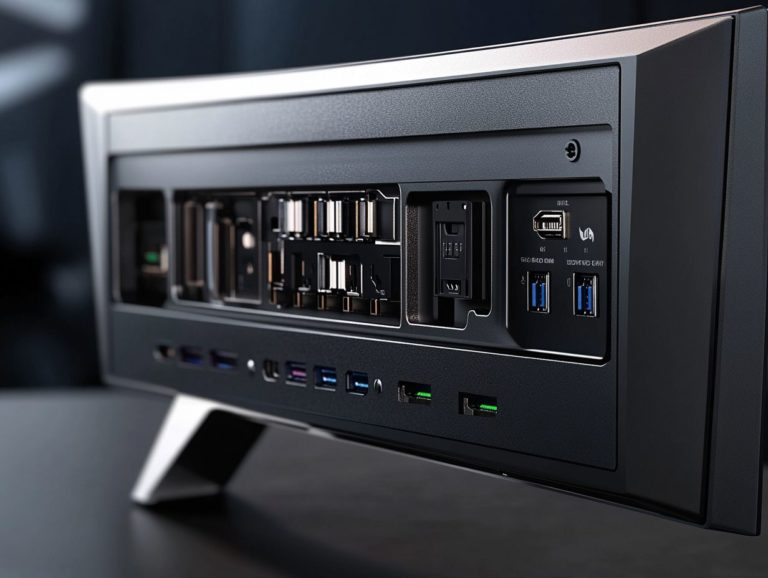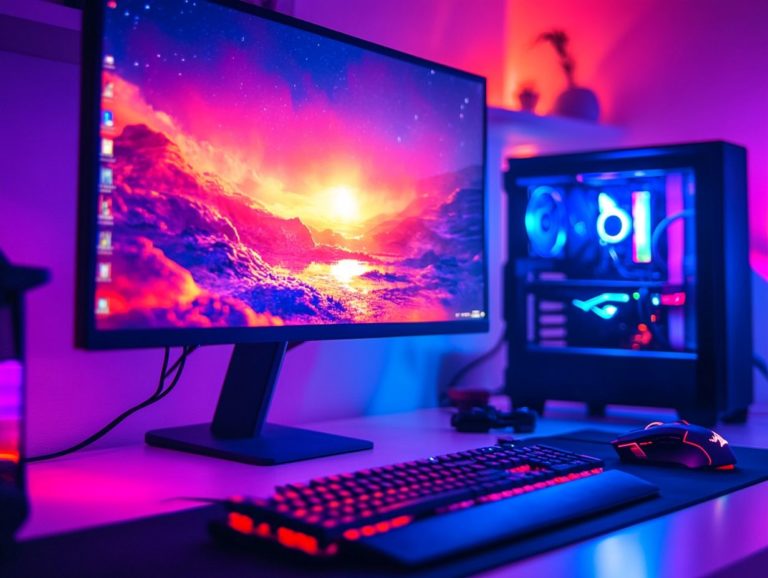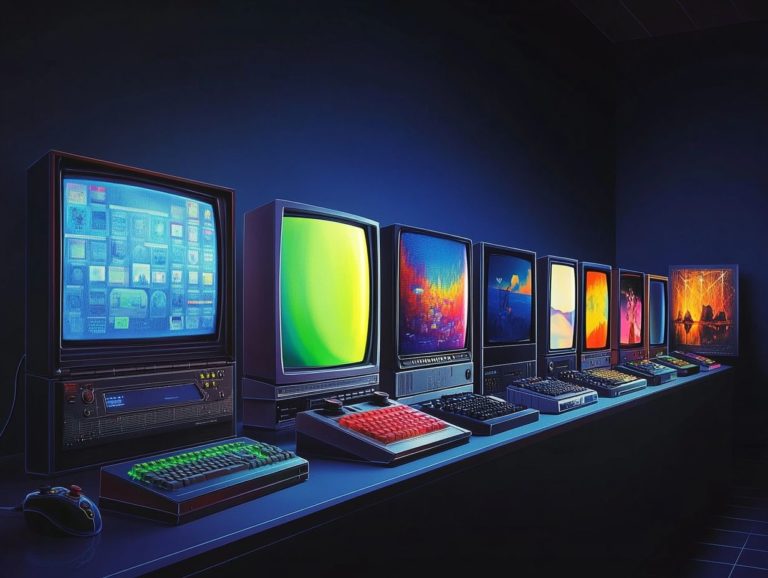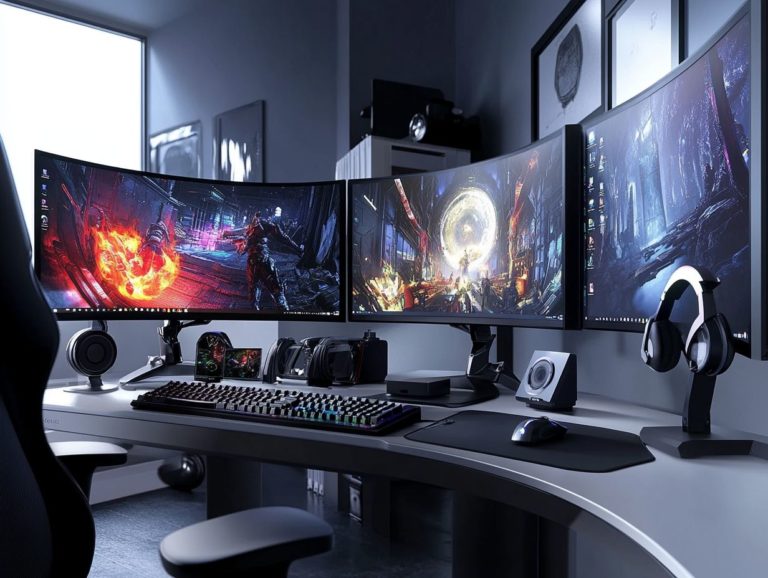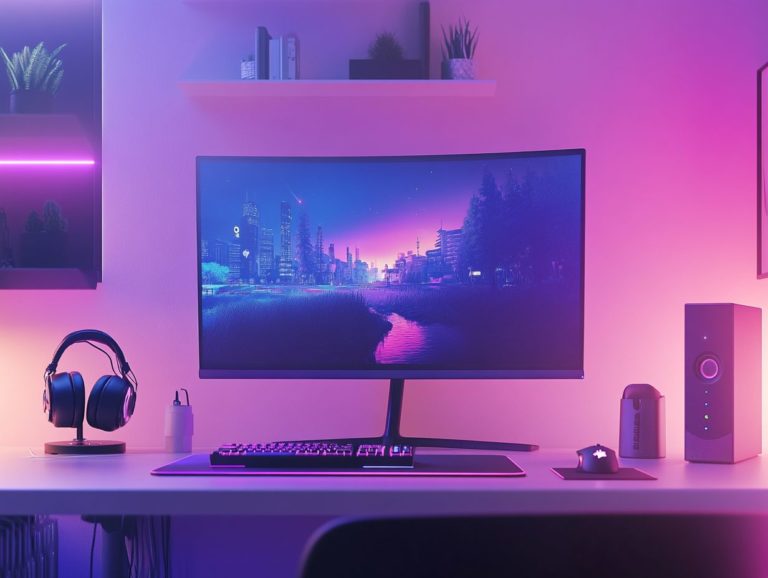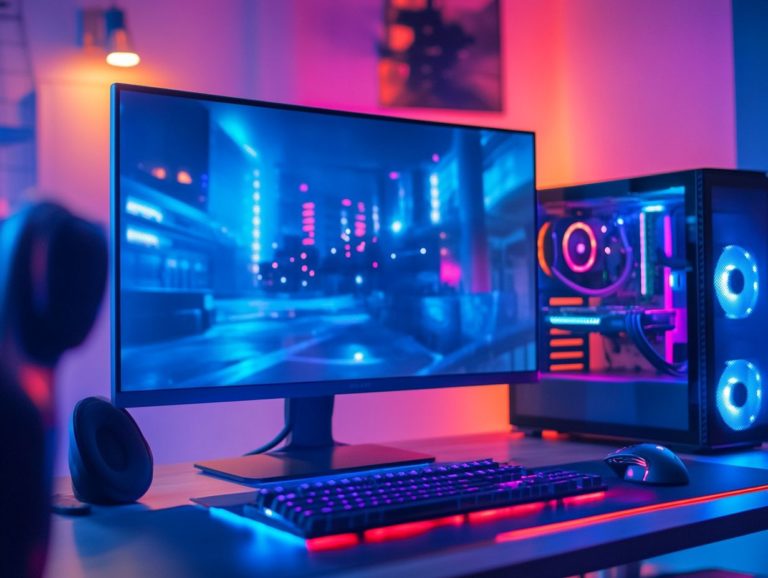top 5 monitors for virtual reality gaming
In the fast-evolving realm of virtual reality gaming, selecting the right monitor can truly transform your experience. Whether you’re immersing yourself in breathtaking landscapes or engaging in intense multiplayer battles, your monitor choice plays a pivotal role in elevating your gaming sessions.
This article highlights the top five monitors designed specifically for VR gaming, ranging from the LG UltraGear 27GL850-B to the Dell Alienware AW3418DW. You will also discover essential factors to consider, such as refresh rates, resolution, and panel types, empowering you to make an informed decision for your immersive adventures.
Contents
- Key Takeaways:
- 1. LG UltraGear 27GL850-B
- 2. Asus ROG Swift PG279QZ
- 3. Acer Predator XB271HU
- 4. Samsung Odyssey G7
- 5. Dell Alienware AW3418DW
- What to Consider When Choosing a Monitor for Virtual Reality Gaming?
- What Is the Refresh Rate and Why Is It Important for VR Gaming?
- What Is the Resolution and How Does It Affect VR Gaming?
- What Are the Different Panel Types and Which Is Best for VR Gaming?
- What Are the Key Features to Look for in a VR Gaming Monitor?
- How Much Should You Spend on a VR Gaming Monitor?
- Conclusion
- What Are the Common Mistakes to Avoid When Choosing a Monitor for VR Gaming?
- How Can You Optimize Your VR Gaming Experience with the Right Monitor?
- What Are the Benefits of Using a Dedicated VR Gaming Monitor?
- What Are Some Other Top Monitors for VR Gaming?
- Frequently Asked Questions
- What are the top 5 monitors for virtual reality gaming?
- What makes the Samsung Odyssey G9 a top choice for virtual reality gaming?
- Why is the ASUS ROG Swift PG279QZ considered one of the top monitors for VR gaming?
- What sets the LG 34GK950F-B apart from other monitors for virtual reality gaming?
- Is the HP Reverb G2 a good choice for virtual reality gaming?
- What makes the Alienware AW3418DW a top choice for virtual reality gaming?
Key Takeaways:
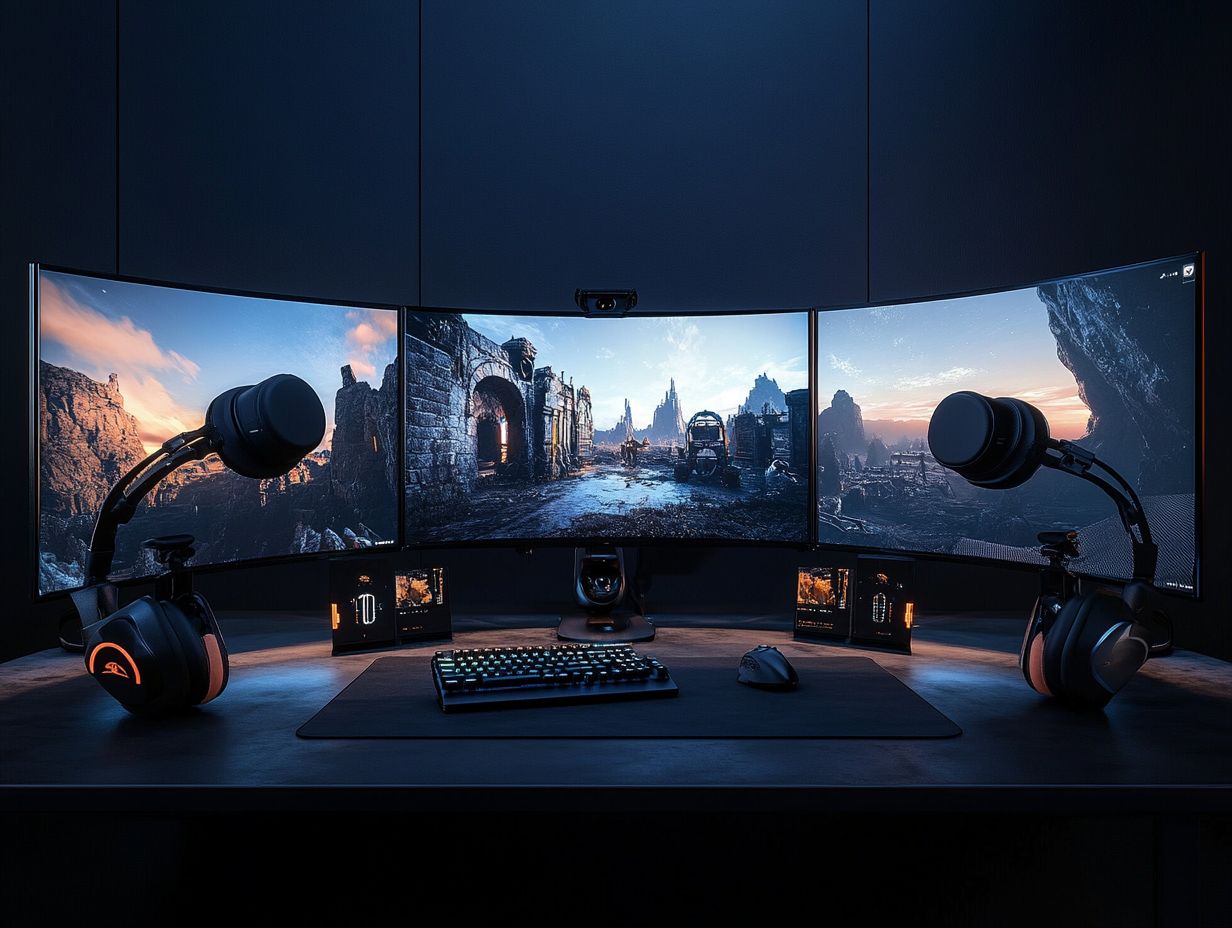
- LG UltraGear 27GL850-B
- Asus ROG Swift PG279QZ
- Acer Predator XB271HU
- Samsung Odyssey G7
- Dell Alienware AW3418DW
When choosing a monitor for VR gaming, consider the refresh rate, resolution, panel type, key features, budget, and optimization options to enhance your gaming experience.
Dedicated VR gaming monitors offer benefits such as higher refresh rates and improved response times. They provide optimized visual settings, making them a worthwhile investment for serious gamers.
1. LG UltraGear 27GL850-B
The LG UltraGear 27GL850-B is your go-to premium gaming monitor, designed to deliver an immersive VR experience. It’s an exceptional choice for gamers who demand nothing less than high-quality visuals and top-tier performance, especially when paired with VR headsets like the Meta Quest 3 or Valve Index.
Experience breathtaking visuals with a stunning 2560 x 1440 resolution and a lightning-fast 144Hz refresh rate! This monitor excels at providing you with crisp imagery and fluid motion, even during the most intense gameplay. Thanks to its Nano IPS panel, you can expect remarkable color accuracy ideal for those who truly appreciate detail and vibrant visuals.
When stacked against other monitors tailored for virtual reality gaming, this one shines with superior tracking performance, allowing for smooth transitions without any lag. Plus, with features like adaptive sync technology designed to reduce screen tearing you ll enjoy a seamless experience that significantly enhances your immersion as you explore vast virtual worlds.
2. Asus ROG Swift PG279QZ
The Asus ROG Swift PG279QZ is designed for high-end VR gaming. It provides stunning display quality and performance metrics that truly elevate your gaming experience, particularly with advanced headsets like the Meta Quest 2 and Pico 4.
With an impressive resolution of 2560 x 1440 and a refresh rate of up to 165 Hz, this monitor ensures razor-sharp visuals and incredibly smooth motion essential for immersive gameplay. These high specifications not only enhance clarity but also minimize motion blur, making every frame feel fluid and responsive.
You will appreciate its compatibility with popular gaming hardware, allowing for a seamless dive into virtual realities. Whether you re exploring vast worlds or engaging in intense battles, the swift response time and vibrant color reproduction will enhance your overall experience, enabling you to lose yourself in the action without distractions.
3. Acer Predator XB271HU
The Acer Predator XB271HU is a state-of-the-art monitor designed to elevate your VR gaming experience. With outstanding specifications that enhance visuals and minimize input lag the delay between your actions and what you see on the screen it ensures seamless gameplay with VR headsets like the Valve Index or Sony PS VR2.
Boasting a refresh rate of up to 165Hz and a remarkable resolution of 2560 x 1440, this monitor features an IPS panel that delivers vibrant colors and superior viewing angles. These attributes are essential in the realm of VR gaming, as they help reduce distractions like the screen door effect that can pull you out of immersion.
By optimizing refresh rates and minimizing response times, you can enjoy smoother tracking performance, resulting in a fluid and realistic gaming experience that feels truly enveloping. These specifications significantly enhance your sense of presence in virtual environments.
Don t wait choose the right monitor for VR gaming by considering the options discussed in this article!
4. Samsung Odyssey G7
The Samsung Odyssey G7 seamlessly combines stunning visuals with an attractive price point, making it an exceptional choice for gamers seeking high-quality images without sacrificing performance especially when paired with VR headsets like the Meta Quest 3!
This monitor showcases an impressive 2560×1440 resolution, ensuring that every graphic is crisp and vibrant, bringing immersive worlds to life.
With a refresh rate soaring up to 240Hz, it provides smooth gameplay that s crucial for fast-paced VR experiences, effectively reducing motion blur and allowing every action to feel instantaneous.
When compared to pricier alternatives, the Odyssey G7 stands its ground, particularly in HDR (High Dynamic Range) performance. It delivers bright highlights and deep shadows that enhance visual depth, elevating your gaming experience.
For budget-conscious gamers, this winning combination of high resolution, rapid refresh rates, and outstanding HDR support makes it an unbeatable value in the realm of VR gaming peripherals!
5. Dell Alienware AW3418DW
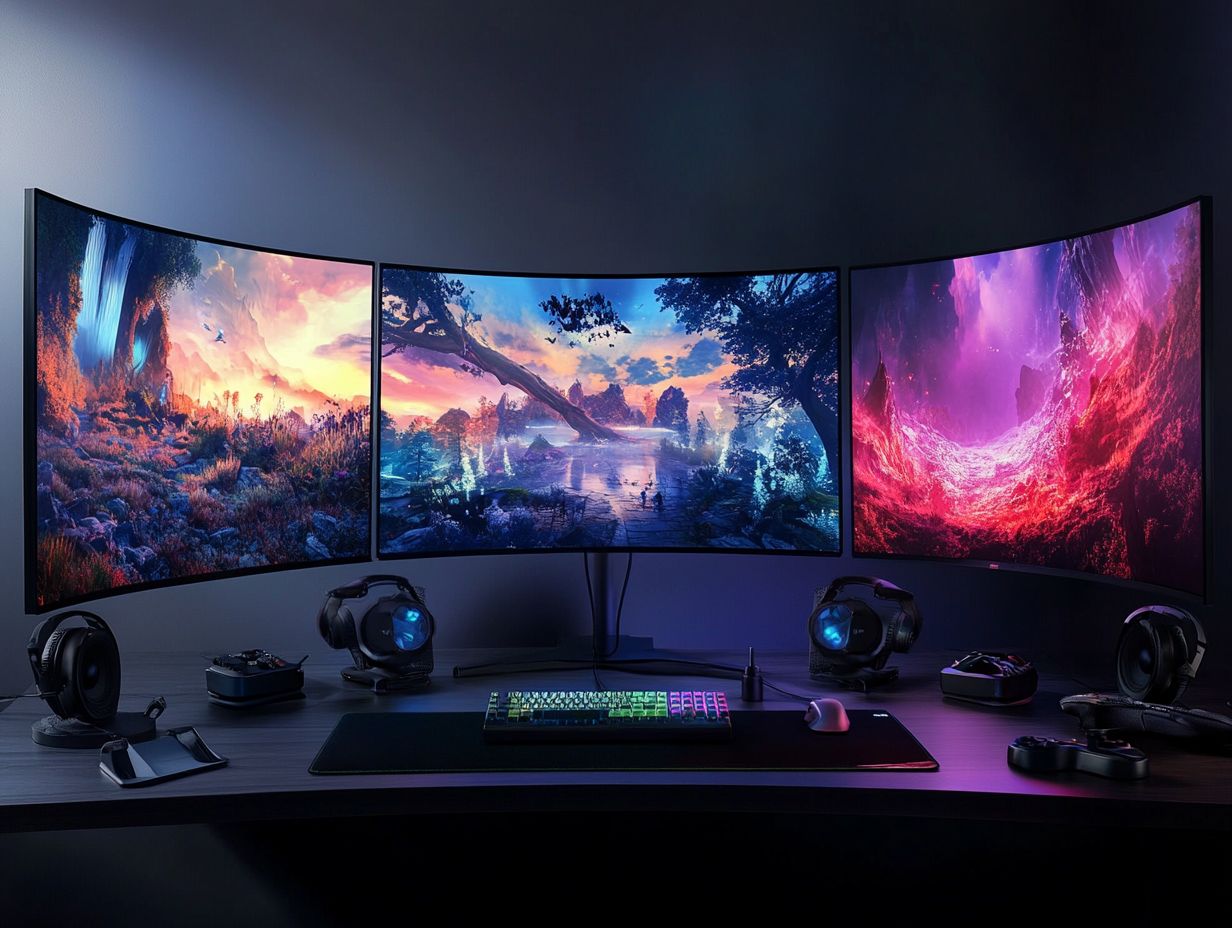
The Dell Alienware AW3418DW is meticulously crafted for an immersive VR gaming experience. Equipped with top-tier specifications, it guarantees fluid motion and stunning visuals. It s the ideal companion for high-end headsets like the Valve Index and HP Reverb G2.
This monitor boasts an expansive 34-inch curved display with a 1900R curvature, providing a wide field of view that enhances your peripheral experience and pulls you deeper into virtual worlds.
With a rapid refresh rate of 120Hz and impressively low input lag, it ensures smooth performance and quick reactions essential for navigating fast-paced environments!
The vibrant colors and sharp resolution elevate realism, allowing every detail from the glow of the virtual sky to the intricate textures of the gaming environment to shine vividly. It s a significant asset for anyone serious about gaming, transforming your setup into a true powerhouse!
What to Consider When Choosing a Monitor for Virtual Reality Gaming?
Choosing the right monitor for your virtual reality gaming setup requires careful consideration of several key factors, such as resolution, refresh rate, and compatibility with VR headsets like the Meta Quest 3. These elements play a crucial role in shaping your overall gaming experience.
Beyond these foundational specifications, pay close attention to tracking performance. Accurate motion capture significantly enhances immersion and responsiveness during gameplay, making each session feel more dynamic!
Audio quality is another essential aspect. Rich and spatial sound can elevate your VR experience, creating a more authentic and engaging environment. Don t overlook comfort an ergonomic setup can drastically reduce fatigue during marathon gaming sessions.
Finally, individual preferences and the specific capabilities of different headsets like visual fidelity, field of view, and ease of use should guide your ultimate decision when selecting a monitor to complement your VR gaming experience!
What Is the Refresh Rate and Why Is It Important for VR Gaming?
The refresh rate is an essential specification in VR gaming, dictating the number of frames displayed per second. This significantly impacts visual quality and your overall gaming experience especially with advanced VR headsets like the Meta Quest 3!
A higher refresh rate leads to smoother animations and less motion blur, making the virtual environment feel incredibly lifelike. This fluidity amplifies your enjoyment and minimizes input lag, which can disrupt gameplay by creating a disconnect between your actions and their on-screen responses.
An optimal refresh rate helps combat the dreaded screen door effect, where visible lines separate pixels and pull you out of the immersive experience. For most gaming scenarios, refresh rates of 90Hz or higher are often recommended.
If you re diving into high-speed action, even greater rates can elevate your experience, ensuring it remains engaging and seamless!
What Is the Resolution and How Does It Affect VR Gaming?
Resolution is crucial in VR gaming because it affects the clarity and detail of virtual environments. This ultimately shapes the immersive experience offered by headsets like the Valve Index and HP Reverb G2.
The differences between resolutions, like 1080p, 1440p, and 4K, can greatly impact how you see your virtual surroundings. A higher resolution reduces the visible lines that can appear on the screen, making the image clearer and allowing you to dive into the experience without distractions.
Color accuracy is essential for creating vibrant, lifelike visuals, which enhances emotional engagement in gameplay. As you move from lower to higher resolutions, you ll discover a captivating world of detail that pulls you deeper into the fictional landscapes you explore.
What Are the Different Panel Types and Which Is Best for VR Gaming?
Understanding the different panel types like IPS, TN, and VA is important when choosing a monitor for VR gaming. Each type has its unique advantages in tracking performance, refresh rate, and overall gaming experience.
For instance, IPS panels are known for their excellent color accuracy and wide viewing angles. They are perfect for immersive experiences where every detail matters.
In contrast, TN panels provide faster response times and refresh rates, making them ideal for competitive gamers who prioritize quick reactions over color depth.
VA panels offer a balance with decent refresh rates and exceptional contrast, catering to anyone who enjoys vibrant visuals.
However, for VR applications, IPS technology often stands out. Its ability to deliver accurate colors and wide angles significantly enhances realism, essential for creating a captivating virtual environment.
What Are the Key Features to Look for in a VR Gaming Monitor?
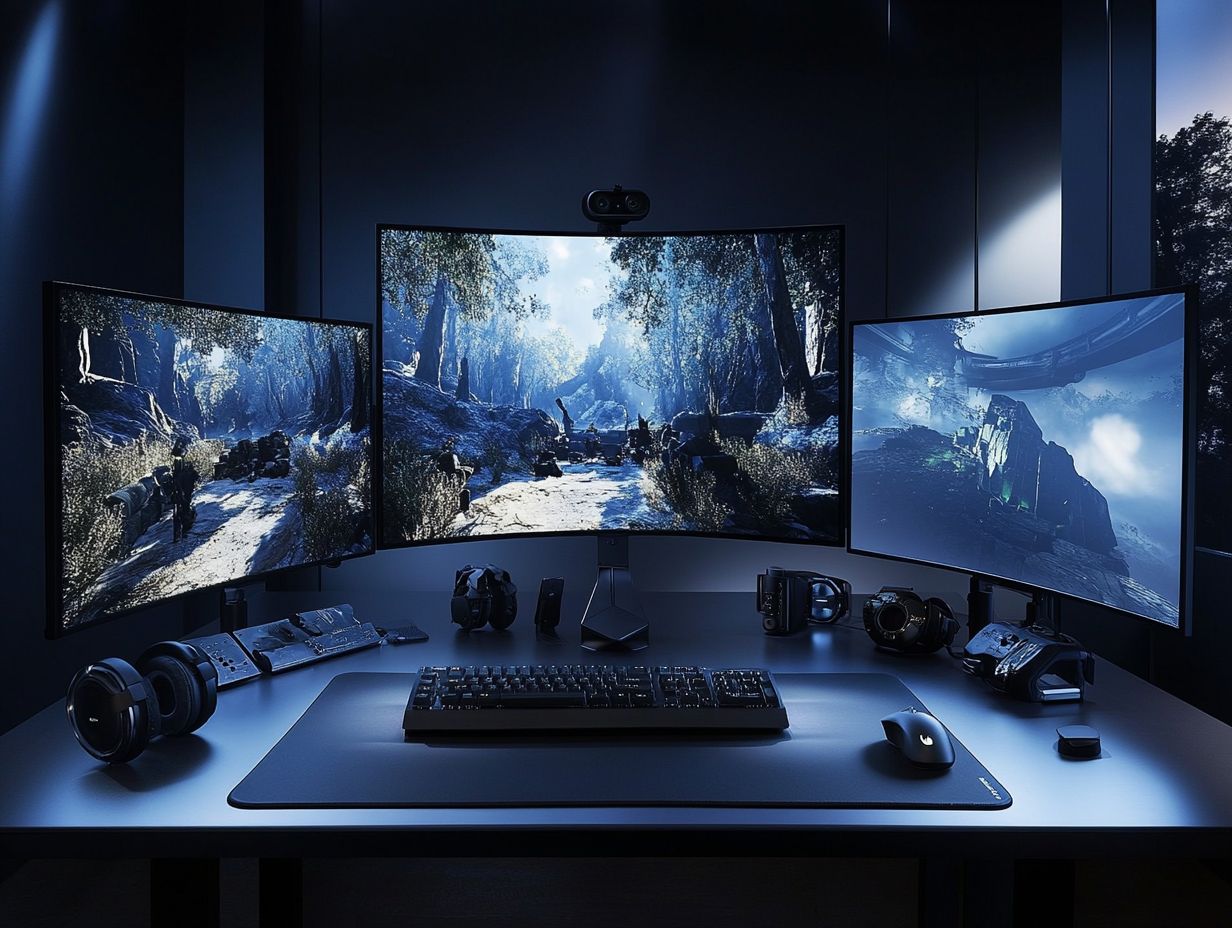
When selecting a VR gaming monitor, keep a close eye on key features like refresh rate, response time, and compatibility with VR headset functions. These elements are vital for improving your overall experience and ensuring peak gaming performance.
Battery life is also important. It lets you enjoy long gaming sessions without worrying about running out of power.
Don t forget about connectivity options! Features like USB Type-C and wireless connections are crucial for seamless integration with various devices, helping you maintain a tidy, tangle-free setup.
Finally, ensure that performance metrics like resolution and brightness match your gaming preferences. This alignment will provide clear visuals and vibrant colors, crafting the ultimate VR gaming environment.
How Much Should You Spend on a VR Gaming Monitor?
So, how much should you spend on a VR gaming monitor? Finding the right balance between your budget and gaming goals is key. Prices can vary widely, from budget-friendly monitors to high-end models that promise immersive experiences, such as the Meta Quest 2.
If you’re on a tight budget, you ll discover amazing entry-level VR monitors in the $200 to $400 range. While these often come with lower resolution and refresh rates, they can still support casual gaming and basic VR applications quite well.
As you move into the mid-range, typically priced between $400 and $800, expect enhanced display quality, improved refresh rates, and a wider field of view all of which significantly elevate your immersive experience.
At the premium end, where prices exceed $800, you ll find monitors with top-tier specifications like 4K resolutions, advanced refresh rates, and features such as eye tracking, which are becoming the norm.
Think about what you love in gaming! Choose a monitor that meets your adventure needs!
Conclusion
In summary, selecting the right VR gaming monitor involves understanding resolution, panel types, essential features, and budget considerations. By focusing on these aspects, you can enhance your gaming experience and fully immerse yourself in the virtual worlds you explore.
What Are the Common Mistakes to Avoid When Choosing a Monitor for VR Gaming?
When selecting a monitor for VR gaming, it s easy to overlook critical specifications like refresh rate and resolution. These factors can greatly influence your experience and enjoyment of captivating gaming worlds.
Don t forget to check if the monitor is compatible with your existing hardware. Incompatibility can lead to frustrating moments when the display can’t keep pace with your system.
Performance tracking is often overlooked but essential for maintaining immersion in expansive virtual environments. Align the monitor’s capabilities with your gaming rig’s specifications to ensure that refresh rates and resolutions match.
Investing time in research on tracking technologies can elevate your gameplay dynamics, resulting in a smoother and more enjoyable VR experience.
How Can You Optimize Your VR Gaming Experience with the Right Monitor?
To optimize your VR gaming experience, selecting the right monitor with appropriate specifications is crucial. A high-quality display, such as one from the top gaming monitors with adaptive sync, can enhance your immersion and performance, especially with headsets like the Pico 4 or Meta Quest 3 (popular virtual reality headsets).
Calibrating your monitor’s settings is also vital. This small detail can improve visual comfort and clarity, allowing you to explore virtual worlds without strain.
A reliable and strong wireless connection is essential too. Lag or interruptions can disrupt your gameplay, leaving you less satisfied.
Don’t overlook high-quality gaming accessories. Precision controllers and tracking devices enhance accuracy, allowing for fluid movements in virtual spaces, enriching your overall experience.
By focusing on these components, you ll fully immerse yourself in the rich environments that VR has to offer!
What Are the Benefits of Using a Dedicated VR Gaming Monitor?
Using a dedicated VR gaming monitor offers numerous advantages that elevate your gaming experience! You’ll notice improved visual quality, reduced input lag, and enhanced tracking performance, creating a truly immersive atmosphere, especially with headsets like the Valve Index.
These monitors generally feature higher refresh rates and greater resolutions, ensuring that every frame remains crisp and fluid essential in fast-paced gaming scenarios. Adaptive sync technologies eliminate screen tearing and stuttering, enriching your visual journey.
A wider color gamut provides richer hues and deeper contrasts, allowing for vibrant virtual worlds. Additionally, dedicated VR monitors often include customizable settings optimized for gaming.
This enables you to fine-tune parameters to align perfectly with your preferences, ensuring maximum comfort and peak performance as you dive into your favorite games!
What Are Some Other Top Monitors for VR Gaming?
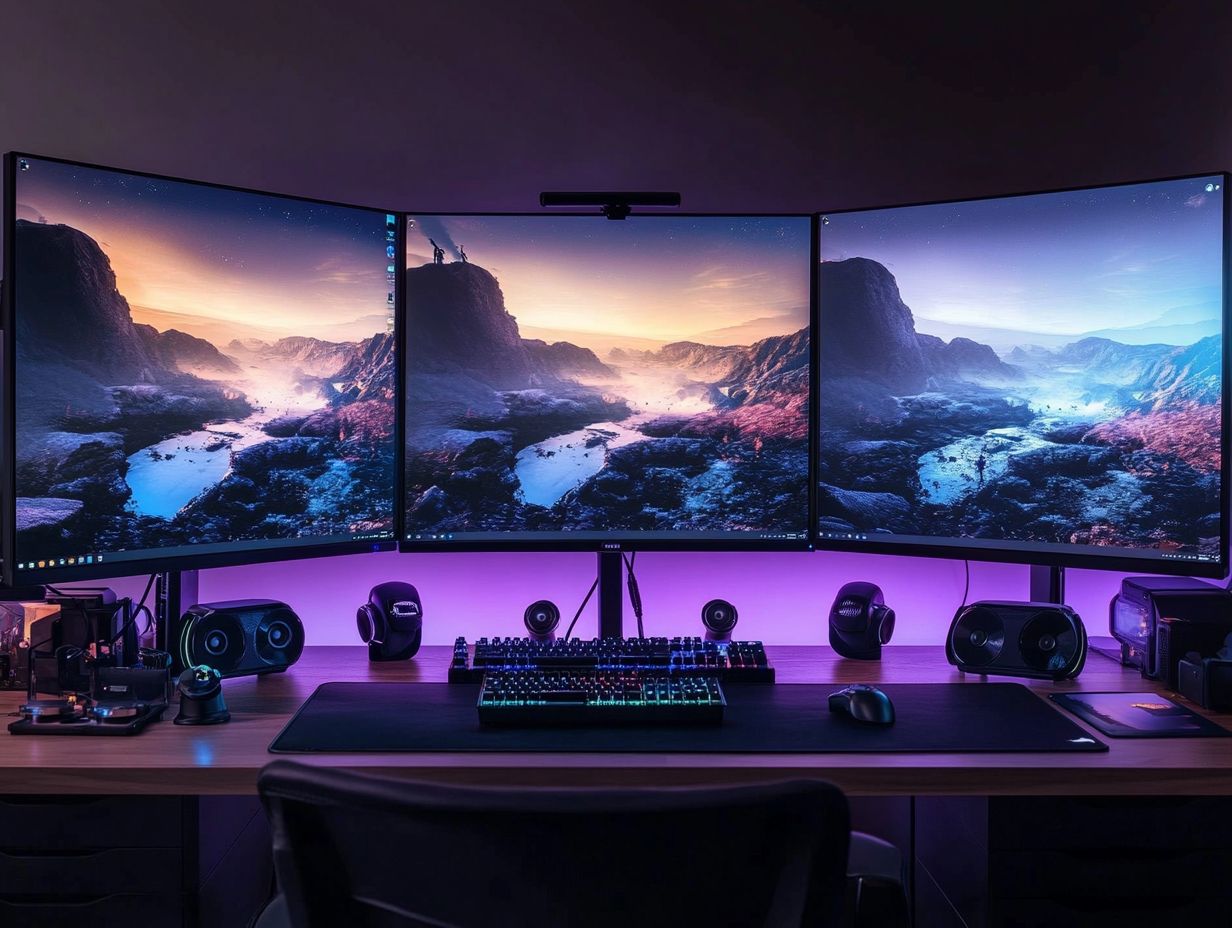
Along with the previously mentioned models, several other top monitors for esports enthusiasts deliver exceptional performance and visual quality, making them perfect companions for headsets like the Meta Quest 3 and Acer Predator XB271HU.
For instance, the ASUS ROG Swift PG259QN boasts an incredible 360Hz refresh rate, ensuring buttery-smooth gameplay even in fast-paced scenarios!
The Dell Alienware AW2521H features NVIDIA G-SYNC technology along with a lightning-fast 1ms response time, which reduces lag and enhances immersion during intense gaming marathons.
These newer models outshine their predecessors with advanced HDR capabilities and ultra-low input lag, offering an unparalleled VR experience.
As technology advances, features like mini-LED backlighting and improved color accuracy are becoming standard, setting a new benchmark for visual fidelity that every gamer can appreciate!
Frequently Asked Questions
What are the top 5 monitors for virtual reality gaming?
Don’t miss out on the chance to elevate your gaming experience with these top monitors:
- Samsung Odyssey G9
- ASUS ROG Swift PG279QZ
- LG 34GK950F-B
- HP Reverb G2
- Alienware AW3418DW
These monitors are known for their high resolution, fast refresh rates, and low response times. They make for a smooth and immersive VR gaming experience.
What makes the Samsung Odyssey G9 a top choice for virtual reality gaming?
The Samsung Odyssey G9 features a curved display with a 240Hz refresh rate and a 1ms response time. This combination creates an immersive and fluid VR gaming experience.
It also boasts a high resolution of 5120×1440 and is compatible with both PC and console VR systems.
Why is the ASUS ROG Swift PG279QZ considered one of the top monitors for VR gaming?
The ASUS ROG Swift PG279QZ offers a 27-inch display with a 165Hz refresh rate and 1ms response time. This ensures smooth and responsive gameplay for virtual reality.
It includes a feature that prevents screen tearing, helping to reduce input lag.
What sets the LG 34GK950F-B apart from other monitors for virtual reality gaming?
The LG 34GK950F-B brings a 34-inch curved display with a 144Hz refresh rate and 1ms response time, making it an excellent choice for immersive VR gaming.
It also has a 21:9 aspect ratio and HDR support, delivering stunning visuals for a more realistic gaming experience.
Is the HP Reverb G2 a good choice for virtual reality gaming?
Absolutely! The HP Reverb G2 stands out with its 4K resolution and 90Hz refresh rate. Inside-out tracking ensures precise movement tracking.
Plus, it offers a comfortable fit and built-in headphones for an immersive audio experience.
What makes the Alienware AW3418DW a top choice for virtual reality gaming?
Get ready for excitement with the Alienware AW3418DW, featuring a 34-inch curved display with a 120Hz refresh rate and a 2ms response time. This ensures a smooth and immersive gaming experience.
It also includes a feature that prevents screen tearing and customizable RGB lighting for a personalized gaming setup.

